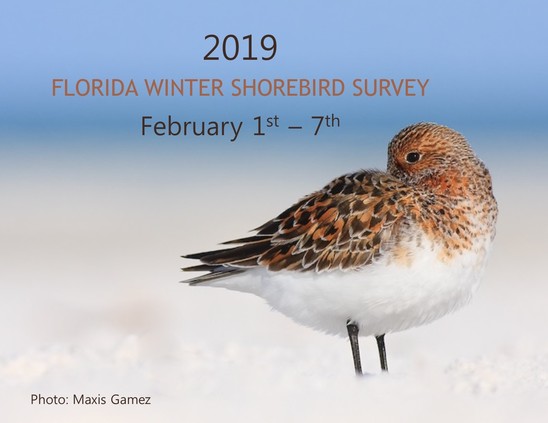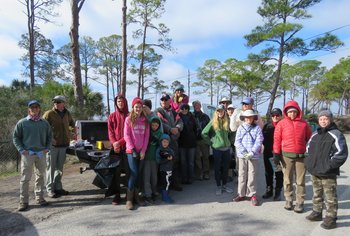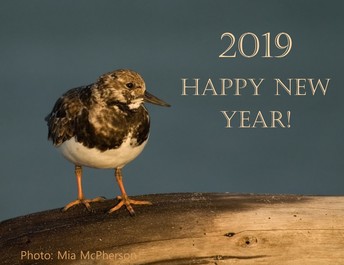Events:
Now - January 5: 119th Christmas Bird Count
January 10: Shorebird Walk at Matanzas Inlet
January 16: Basic Shorebird ID at Gamble Rogers SP
January 17 - 21: Everglades Birding Festival
January 17 - 21: North Shore Birding Festival
January 18 - 20: Rookery Bay Festival of Birds
January 23 - 28: Space Coast Birding & Wildlife Festival
January 29: Fort De Soto Shorebirds & Ducks
 Partner Spotlight: David Hartgrove of Volusia County Shorebird Partnership
David Hartgrove has been a member of the Volusia Shorebird Partnership since its first meeting in 2009. However, his history with birding and bird conservation in Florida goes back much, much farther.
David was born in High Point, North Carolina but his family moved to Miami when he was just 2 years old. He served in Vietnam in the U.S. Navy Seabee and returned home to what became a long career with Florida Power and Light (FPL).
In 1973 David had a “spark bird” experience while on break, sitting in his FPL truck with his co-worker, Ricky Ray. They weren’t talking about birds or nature. (FPL linemen, being a somewhat macho bunch, don’t normally speak of such things unless they want to be kidded by co-workers!) Just then, a flock of sparrows flew by and a small predatory bird flew in and took one of the birds. Moments later it impaled its prey on a barbed wire fence. David watched spellbound as the bird went back and forth to feed its young in a nearby nest. Ricky turned out to be an avid birder and explained that the bird was a loggerhead shrike and gave David the play-by-play of what was happening and why. David purchased his first field guide the next day. His passion for birding and bird conservation was ignited.
David moved to Daytona in the early 80s where he joined the Halifax River Audubon Society. In 1985, David was watching an early morning news program featuring Wes Biggs. Wes mentioned a new initiative where volunteers were needed; Florida’s first Breeding Bird Atlas Project. David volunteered and worked tirelessly on this project. His knowledge continued to grow as he learned from experienced birders in the area.
In 1994, David was contacted by a high school biology teacher in Daytona Beach. Spruce Creek Park was opening and the teacher was looking for people to teach outdoor classes in wildlife identification and biology. David volunteered to teach bird biology and identification and has been teaching there each year, ever since. These days, 10 different Volusia County high schools participate in the program. In 1996, David also led the way in re-establishing the Daytona Beach Christmas Bird Count.
David currently acts as the Conservation Chair and Vice President of Halifax River Audubon (HRA). He’s also the editor of the HRA newsletter. David works with local FSA partners to monitor nesting wading birds and brown pelicans at the Port Orange Critical Wildlife Area (a site he championed for CWA establishment). He kayaks to islands in the surrounding “Port Orange Wildlife Sanctuary” to survey for nesting American oystercatchers and other species. David also monitors most of the gravel rooftop nesting areas in Volusia County each year. He’s also known to be available at a moment’s notice to help post sensitive nesting areas. David helped FWC post a portion of a cleared construction site, near Tanger Outlet mall where least terns where nesting about 50 yards from where approaching bulldozers were operating!
In his spare time, David works with Florida Nature Tours to lead birding adventures to Key West and the Dry Tortugas. He is a great example of an FSA partner and FWC volunteer doing amazing things for bird conservation here in Florida. Thank you, David, for your long-term dedication to shorebirds and seabirds!
|
 |
Florida Winter Shorebird Survey
Florida’s Annual Winter Shorebird Survey starts on Friday, February 1st and continues through Thursday, February 7th. This week-long survey serves as the official statewide snapshot of coastal wintering shorebirds and seabirds in Florida. Please check the FSA website and Facebook group in mid-January for more details and to participate. We hope you enjoy this fun and challenging winter survey and Thank You for your continued efforts!
 Dedicated Volunteers Clean Up Critical Wildlife Area
After Hurricane Michael swept through the Florida panhandle a large amount of garbage washed up on panhandle beaches, many of which are critical shorebird and sea turtle nesting grounds. In an effort to give back to the community and help protect wildlife, Audubon Florida and Florida Fish and Wildlife Conservation Commission (FWC) organized a beach cleanup at a Critical Wildlife Area. In early December more than a dozen volunteers armed with gloves and trashcans hit the beach on an outlying peninsula known as Alligator Point.
Located in Franklin county, Alligator Point is owned and managed by The Nature Conservancy (TNC). It is one of five established Critical Wildlife Areas in Northwest Florida and is considered an important nesting area for state-threated American oystercatcher, least tern and the Wilson’s plover. Emergent lands of this 145-acre preserve are posted each spring and closed to the public between February 15 and September – a measure introduced in 1984 to protect wildlife from human impact.
Misplaced trash impacts thousands of seabirds, marine mammals and turtles each year through ingestion and entanglement. Common items like fishing line, string, and six-pack rings are particularly harmful as they hamper mobility and cause injury to wildlife. Entangled animals have trouble eating and breathing which can have fatal results. Plastic pieces, balloons, and bags are often detrimental to marine life because it is mistaken for food. Marine debris may cause choking, impaction, and starvation which can lead to death.
Knowing how harmful marine debris is on wildlife and the beach made the cleanup effort at Alligator Point worthwhile. By the day’s end, the volunteer team removed two pickup trucks worth of plastic and Styrofoam debris, a stack of chemical preserved wood, and buckets worth of hazardous household cleaners, oil and gasoline tanks.
Thank you to TNC and everyone that participated in the beach cleanup of one of Florida’s Critical Wildlife Areas. Your efforts help give the shorebirds, seabirds and other wildlife a chance at a better tomorrow.
(Volunteer crew photo by Bonnie Samuelsen)
|

It may not be breeding season, but the FSD team is busy! The non-breeding season gives our team the opportunity to archive and analyze the 2018 data, and get ready for the season ahead. We are wrapping up quality control, making improvements to the FSD website, and sprucing up the annual training materials.
Based on partners’ experiences, we have made a few changes to the Breeding Bird Protocol and FSD website that will facilitate even better data collection. Stay tuned to the Wrack Line for details coming this spring!
As always, if you have data requests, suggestions for improvement, or general inquiries email us at FLShorebirdDatabase@myFWC.com.
 |
|
We Wish You A Happy New Year!
Thank you for helping the Florida Shorebird Alliance succeed in 2018. We look forward to a new year of making conservation gains for our beloved shorebirds and seabirds!
|
|